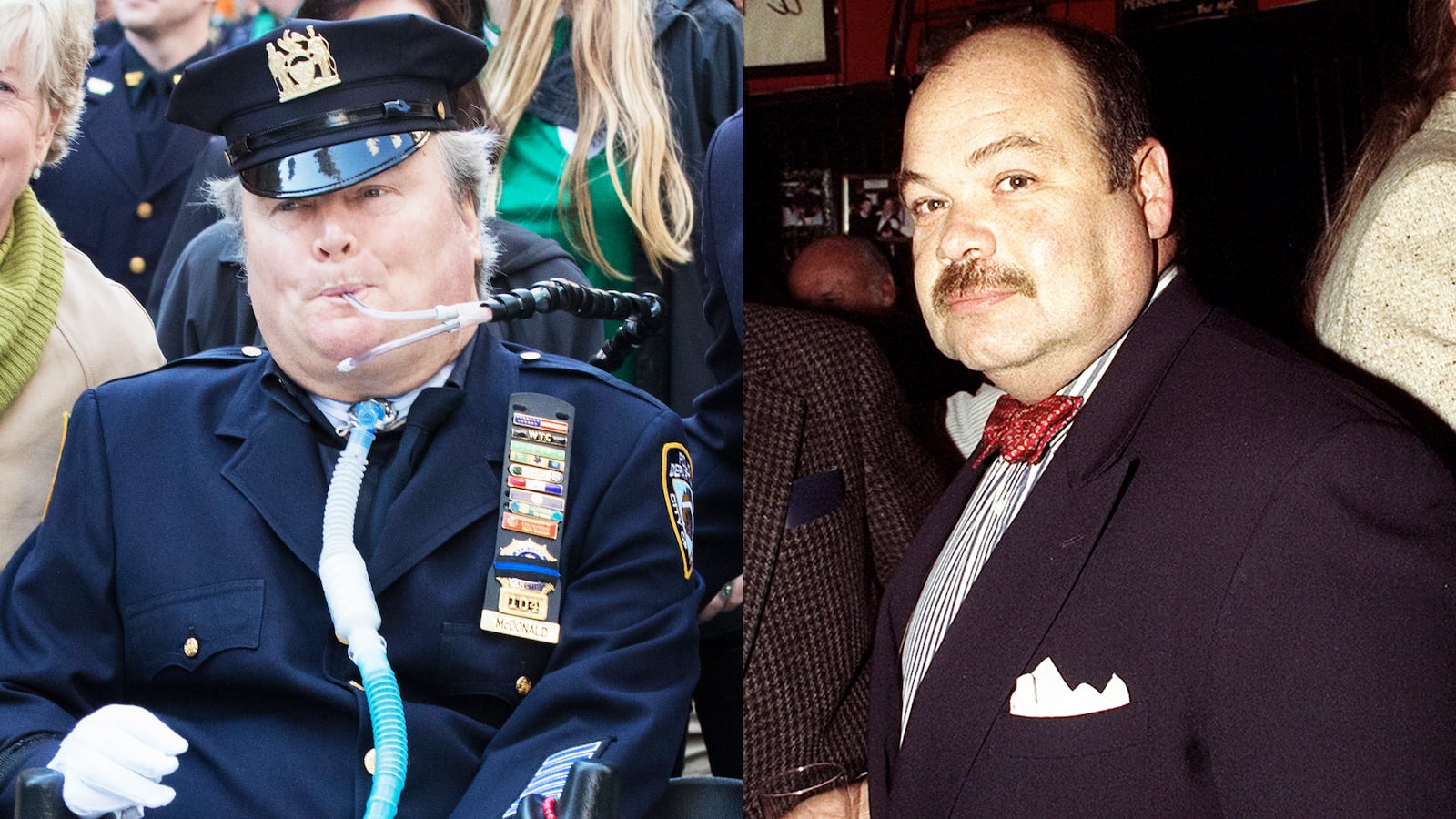Winter 1986
Registered Nurse Nina Justiniano placed a stool beside the hospital bed where 28-year-old Police Officer Steven McDonald lay paralyzed below the joining of his neck and head. He had been shot three times by a 15-year-old suspected bicycle thief who had suddenly pulled a gun on an overcast summer afternoon in Central Park five months before. The last bullet had been fired directly into his face, nicking his right eye as he was sprawled on his back. Bullet fragments and bits of bone still impinged on his spine at C2, the second of the seven cervical vertebrae. That is the connection a hangman seeks to break.
Steven remained unable to speak or even breathe on his own and the whoosh… whoosh… whoosh of a Bennett 5200 ventilator filled this room on the tenth floor of Bellevue Hospital. The facility’s chief doctor had decided that he would be better off dead.
Steven had been offering the same conclusion, repeatedly mouthing four words that Nina had lip-read when she first began caring for him.
“I want to die.”
“No, that’s not happening today,” Nina had told him. “Because I don’t make money with dead bodies. You die, and my check is cut off.”
Steven had done something he would not have expected to do even if he were able. He laughed.
“Today is not the day, Steven,” Nina had continued. “You’re not going anywhere. You’re going to stay right here with us.”
But Steven had soon fallen back into hopelessness. Nina had feared she was going to lose him despite her best efforts.
“People die because they lose the will to live,” she would later say. “Steven was at that crossroads.”
The whoosh… whoosh… whoosh was now joined by the sound of Nina pulling the privacy curtain closed after setting down the stool. She summoned Steven’s wife, Patti Ann McDonald, who was 23 and had gone from three to seven months pregnant since the shooting. Nina was 34 and figured from her own experience as an expectant mother that the baby’s movements would have become pronounced enough for her plan to rescue Steven from despair.
“Lift your blouse and put your belly to Steven’s face,” Nina would remember telling her.
Patti Ann got on the stool and leaned over. Her face appeared above Steven, just as in a vision that had come to him moments after the shooting, when he was bleeding and losing consciousness, silently pleading to God not to let him die.
Only now her face was eclipsed by the swell of her tummy. It was warm, tautly soft against his cheek. And then…
Yes.
He could feel it. All the more vivid in the absence of any other sensations.
“That’s your baby,” Nina told him.
Steven mouthed a reply.
“My baby.”
He kissed Patti Ann’s tummy.
“Look what you do!” Nina teased.
The eclipsing tummy pulled away, but the feel of the movement against his face stayed with Steven as Patti Ann stepped off the stool.
“Steven needed to know that was a life that grew in his wife’s womb,” Nina would recall. “That was God’s will that we give life, and he needed to feel that life. That’s what gave Steven hope.”
She would conclude, “That baby saved his life before that baby was even born.”

"New York's Finest: Stories of the NYPD and the Hero Cops Who Saved the City."
TwelveHad Steven died, he would have added one more to the 1,598 total of murders in New York that year. That was up from 1,392 the year before and on the way past 2,000 in New York’s seemingly inexorable unraveling into Fear City.
But a cop who had been gunned down by a teen who embodied pathologies generated by social inequities in Harlem survived with the help of this nurse who embodied the same neighborhood’s great strengths. And the stirring against his cheek set in motion thoughts and emotions that churned in him along with Nina’s wisdom and Patti Ann’s love and a magical priest’s prayer as well as his own essential decency distilled from family tradition. The startling result would become known to the whole city at the baby’s christening.
At that hospital chapel baptism eight months after the shooting and before he had fully regained the ability to speak, Steven would make a remarkable declaration that reminded New York how good the city could be even when things seemed to be at their worst. He would remain a reminder to his fellow cops of what was best in them even as some of their number became dispirited, a few also turning brutal or corrupt.
At the time of Steven’s declaration, a young Transit Police sergeant named Jack Maple was riding through New York’s underground in pink high-top sneakers with a squad of decoy cops, developing strategies that would eventually transform the city. The underlying principle arose in part from the officially unsolved murder of Jack’s deaf-mute grandmother and the subsequent demise of his deaf-mute grandfather in the decade before he was born. What he viewed as the NYPD’s failure to aggressively investigate the deaths added to his determination from his first days as a “cave cop” to treat every crime as if the victim were a member of his family.
The result was a subterranean success so remarkable that when former chief of the Transit Police William Bratton became head of the NYPD in 1994, he elevated Jack in one unprecedented jump to deputy police commissioner. Jack would compare it to a Coast Guard ensign suddenly becoming a Navy admiral.
Jack traded in his pink high-tops and emerged from the subway to become an instantly recognizable NYPD icon in two-tone spectator shoes, bow tie, and homburg hat. He wore a straight tie only one day a year.
“You’re dressing normal today,” a chief at headquarters remarked.
“It’s Halloween,” Jack replied.
Steven McDonald also became an NYPD icon, a noble figure in a mechanized wheelchair outfitted with a ventilator. He’d served the public as a reminder of the risks cops take every day. The cops already knew that all too well. His power for them was as a reminder that they really could be the Finest, no matter how bad it got.
“He was a shining example of what every police officer should be,” his driver, dear friend, and fellow cop Jon Williams noted. “He did more in that chair than able-bodied police officers could do for the police department.”
As Steven sat in dress blues at department dedications and funerals, he was unable to raise his hand to salute. But his very presence was a salute to everything worth honoring.
Inspired by the spirit of one icon and guided by the smarts of another, the cops of the NYPD who truly deserved to be called the Finest brought the annual murder count down to 290 in 2017, the lowest per-capita rate in more than seventy years.
That was 25 fewer homicides than in 1948, the year the movie The Naked City was released. The documentary-style film depicted a fictional investigation into the killing of a young model. It is best known for its final line: “There are eight million stories in the naked city. This has been one of them.”
In fact, the actual story count far exceeds the number of New Yorkers, which is now up to 8.4 million. There are hundreds of tales involving just Steven and Jack.
And many thousands more about the finest of the Finest.
Excerpted from NEW YORK’S FINEST: Stories of the NYPD and the Hero Cops Who Saved the City ©2021 Michael Daly and reprinted by permission from Twelve Books/Hachette Book Group.


